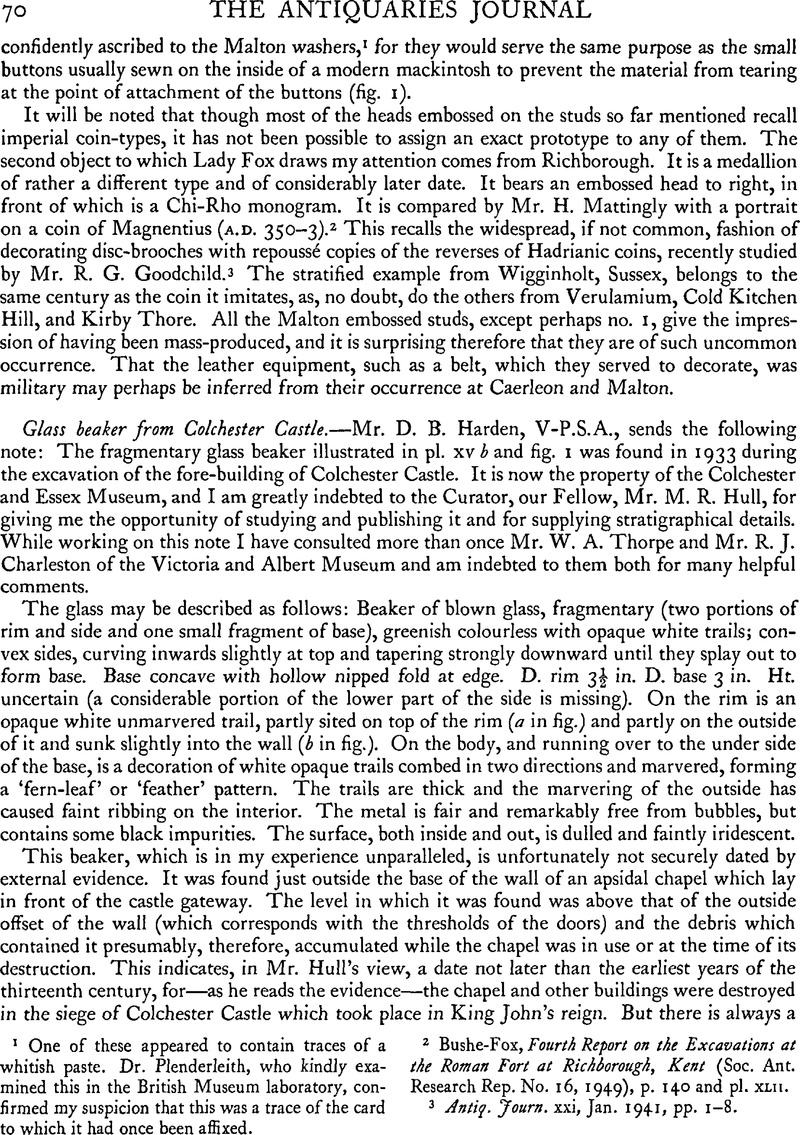Article contents
Glass beaker from Colchester Castle
Published online by Cambridge University Press: 29 November 2011
Abstract

- Type
- Notes
- Information
- Copyright
- Copyright © The Society of Antiquaries of London 1950
References
page 71 note 1 Two sand-core beakers with feather decoration were indeed found in a XXIst Dynasty tomb in Egypt (Fossing, Glass Vessels before Glass-blowing, p. 20, figs. 11–12), but they are of plain flower-pot shape, and much smaller.
page 71 note 2 e.g. Morin-Jean, , Verrerie, p. 201, fig. 269Google Scholar; cf. also fig. 1, no. 5 below, p. 73, from Glaston, Rutlandshire.
page 71 note 3 e.g. op. cit., pp. 142 f., 215, figs. 193,194, 290 ff.
page 71 note 4 F. Fremersdorf, R. G. aus Köln2, fig. 7; H. Lehner, Bonn Führer2, pl. XVI, I.
page 71 note 5 Mon. Antichi, XII (1902), 145 ff.; A. Kisa, Das Glas im Altertume, pp. 396, 412 ff., and pl. IV (opp. p. 420).Google Scholar
page 71 note 6 Fornvännen, 1937, p. 77, fig. 13.
page 71 note 7 London Museum Medieval Catalogue, p. 293, pl. 84 (from the Pyx Chapel, Westminster); and unpublished examples in the British Museum from Restormel Castle (Cornwall).
page 71 note 8 Several pieces from Sweden are cited by Lamm, C. J., Oriental Glass of Mediaeval Date found in Sweden … (Stockholm, 1941), pp. 64, 70 ff.Google Scholar
page 72 note 1 Normally wine-coloured or blue: Lamm, Mittelalterliche Gläser, pls. 29–32; cf. also pls. 104, 105, and 111 (no. 13), though these examples are more elaborate than our piece, having gilt decoration as well.
page 72 note 2 Cf. Ricart, G. and De Artiñano, , Macaya Collection (1935), pl. II, who describe it as Arab, 13th-14th century.Google Scholar
page 72 note 3 Cf. Rademacher, F., Die deutschen Gläser des Mittelalters, fig. 14, pls. 33 and 38.Google Scholar
- 2
- Cited by


